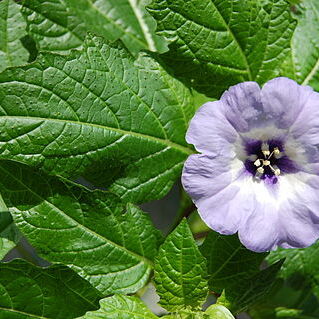Herbs, with simple and glandular hairs. Leaves petiolate; leaf blade simple. Flowers solitary, axillary or in branch forks, pedicellate, actinomorphic. Calyx campanulate, deeply 5-parted. Corolla campanulate, shallowly lobed; lobes ovate. Stamens included, inserted on corolla tube; filaments slender; anthers elliptic, dehiscing longitudinally. Ovary 3-5-locular; ovules numerous. Style filiform; stigma subcapitate, 3-5-lobed. Fruiting calyx conspicuously enlarged, persistent, enclosing fruit, lobes cordate-sagittate, each with 2 basal auriculate lobes. Berry globose, dry. Seeds reniform-discoid, compressed, pitted; embryo much curved, subperipheral, cotyledons subcylindric.
Unarmed, erect, almost glabrous annual. Lvs alternate, simple, often lobed. Fls solitary, axillary. Calyx very deeply 5-toothed, regular, becoming enlarged and scarious at fruiting, with 5 large ribs. Corolla broadly campanulate, completely actinomorphic, white and blue; lobes small. Stamens 5, included, inserted at base of corolla. Ovary 3-5-celled, but divided irregularly by the placentae; stigma capitate. Fr. a scarcely succulent berry, globose. Seeds many, lenticular, with patterned testa, of moderate size.
Stamens ± equal, usually inserted near the base of the corolla tube, included or occasionally subexserted; filaments widened and densely hairy at the base, geniculate where adhering to the corolla, overarching the ovary; anthers connivent, ovate, oblong-sagittate or oblong in outline, glabrous or with a few short hairs, basifixed, the thecae basally separated for more or less a quarter of their length, dehiscing by longitudinal slits.
Cal deeply 5-parted, its lobes imbricate, accrescent and reticulate-veiny in fr, much surpassing the berry, with projecting margins and auriculate base; cor broadly campanulate, shallowly 5-lobed; stamens included; filaments hairy below; anthers short, longitudinally dehiscent; ovary 3–5-locular, with a slender style and 3–5-lobed stigma; berry enclosed by the cal, dry, many-seeded, eventually opening irregularly. Monospecific.
Ovary ovoid, 3–5-locular with false dissepiments; ovules hemicampylotropous, numerous in each locule, on a much enlarged and unevenly lobulate placenta arising from near the central angle of two dissepiments; style short or ± elongate, thickened, terete, glabrous or with a few short hairs; stigma ± capitate, with 3–5 prominent areas, included or occasionally subexserted.
Corolla inserted at the base of the ovary and separated from the calyx by an unusually long internode, tinged blue to purple, ± broadly campanulate to rotate, occasionally infundibuliform; tube very short, hairy inside near the insertion of the stamens; limb subentire to shallowly 5-lobed, the lobes with quincuncial or somewhat conduplicate-contorted aestivation.
Fruit a many-seeded globose berry, shortly stipitate on the base of the calyx and enveloped by the thin-walled semi-translucent stiff accrescent calyx, 3–4-locular, with 5 concretions of seed-sized stone cells in the apical region of the mesocarp, irregularly dehiscent.
Calyx longer than the corolla tube, 5-parted, reduplicate-valvate, segments acute, cordate-sagittate at the base; fruiting calyx much enlarged, chartaceous.
Seeds numerous, compressed, reniform-orbicular in outline; testa somewhat leathery, reticulate-pitted; embryo strongly curved, flattened; endosperm fleshy.
Leaves alternate, the upper ones sometimes in pairs with one leaf larger than the other, appearing opposite, petiolate, coarsely dentate-lobed to entire.
Flowers solitary, axillary or extra-axillary, actinomorphic; pedicel slender, drooping, often pendulous in fruit.
Stems hollow; branches ± angular and sulcate.
Annual ± glabrous herbs.
Disk none.

